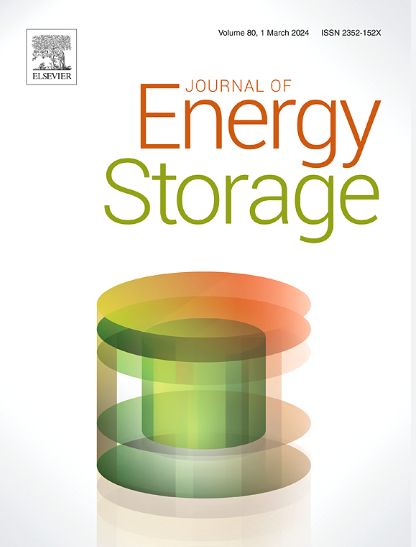壳管潜热储热系统热性能增强的实验和数值研究:翅片、偏心和壳几何的影响
IF 8.9
2区 工程技术
Q1 ENERGY & FUELS
引用次数: 0
摘要
潜热储存(LHS)系统是实现高效和低排放能源解决方案不可或缺的一部分。然而,大多数相变材料(PCMs)固有的低导热性限制了传热速率,因此需要先进的增强技术来改善热响应和整体系统性能。本文研究了翅片添加、管偏心和壳体几何形状对壳管式LHS机组热性能的综合影响。制作了8个圆形和圆形外壳几何形状的透明LHS单元,其管的偏心率分别为0、0.2、0.4和0.6。每个单元都有不同的鳍安排,同时保持恒定的鳍和PCM体积。采用实验可视化和数值模拟来评估关键的热性能指标,包括熔化时间、传热速率和时间平均传热速率。结果表明,将离心系数从0提高到0.6,圆壳和圆壳的熔化时间分别缩短58%和29%,时间平均换热率分别提高109%和33%。比较两种几何形状在一定偏心系数下的熔化时间,发现圆形壳的熔化时间明显短于圆形壳。然而,这种优势随着偏心率的增加而减弱。偏心系数为0%、0.2%和0.4%时,圆壳的熔化时间分别比圆壳短40%、22%和10%,相应的时间平均换热率分别提高58%、9%和2%。在偏心系数为0.6时,两种壳体几何形状的熔化时间没有显著差异。本文章由计算机程序翻译,如有差异,请以英文原文为准。
Experimental and numerical investigation of thermal performance enhancement in shell-and-tube latent heat storage systems: effects of fins, eccentricity, and shell geometry
Latent heat storage (LHS) systems are integral to achieving efficient and low-emission energy solutions. However, the inherently low thermal conductivity of most phase change materials (PCMs) limits heat transfer rate, necessitating advanced enhancement techniques to improve thermal response and overall system performance. This study investigates the combined effects of fin addition, tube eccentricity, and shell geometry on the thermal performance of shell-and-tube LHS units. Eight transparent LHS units with circular and obround shell geometries were fabricated, incorporating tube eccentricities of 0, 0.2, 0.4, and 0.6. Each unit featured a different fin arrangement while maintaining constant fin and PCM volumes. Experimental visualization and numerical simulations were employed to evaluate key thermal performance metrics, including melting time, heat transfer rate, and time-averaged heat transfer rate. The results revealed that increasing the tube eccentricity factor from 0 to 0.6 reduced the melting time by 58 % and 29 %, and improved the time-averaged heat transfer rate by 109 % and 33 % for circular and obround shells, respectively. Comparing the melting times between the two geometries at constant eccentricity factors demonstrated that obround shells exhibited significantly shorter melting times than circular shells. However, this advantage diminished with increasing eccentricity. At eccentricity factors of 0 %, 0.2 %, and 0.4 %, the melting times of obround shells were 40 %, 22 %, and 10 % shorter than those of circular shells, with corresponding improvements in time-averaged heat transfer rates of 58 %, 9 %, and 2 %, respectively. At an eccentricity factor of 0.6, there was no significant difference in melting times between the two shell geometries.
求助全文
通过发布文献求助,成功后即可免费获取论文全文。
去求助
来源期刊

Journal of energy storage
Energy-Renewable Energy, Sustainability and the Environment
CiteScore
11.80
自引率
24.50%
发文量
2262
审稿时长
69 days
期刊介绍:
Journal of energy storage focusses on all aspects of energy storage, in particular systems integration, electric grid integration, modelling and analysis, novel energy storage technologies, sizing and management strategies, business models for operation of storage systems and energy storage developments worldwide.
 求助内容:
求助内容: 应助结果提醒方式:
应助结果提醒方式:


